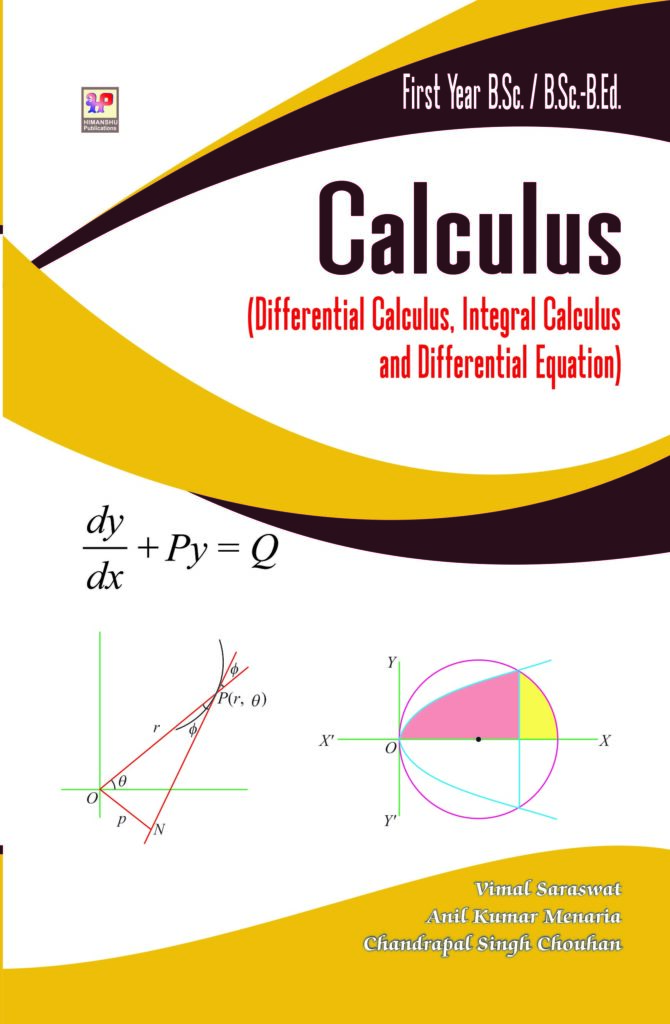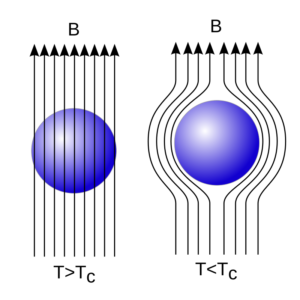Calculus
Differential Calculus, Integral Calculus and Differential Equation

Authors: Dr. Vimal Saraswat, Dr. Anil Kumar Menaria, Dr. Chandrapal Singh Chouhan
This book includes the following topics
Pedal Equations and Derivative of the Length of an Arc
- Polar co-ordinates
- Relation between cartesian and polar co-ordinates
- Angle between radius vector and tangent
- Angle of intersection of two polar curves
- Polar tangent, subtangent, normal, subnormal and their lengths
- Perpendicular from pole to tangent and its length
- Pedal equation
- Differential coefficient of length of the arc
When the equation of curve is in cartesian form (x, y); When the equation of curve is in polar form (r, ፀ)
- Other formula
Mean Value Theorem
- Introduction
- Rolle’s Theorem
- Geometrical interpretation of Rolle’s theorem
- Algebraic interpretation of Rolle’s theorem
- Another form of Rolle’s theorem
- Lagrange’s mean value theorem
- Another form of Lagrange’s mean value theorem
- Geometrical interpretation of Lagrange’s mean value theorem
- Some important deduction from Lagrange’s mean value theorem
- Cauchy’s mean value theorem or first mean value theorem
- Another useful form of Cauchy’s mean value theorem
- General mean value theorem
- Second mean value theorem
- Generalised mean value theorem or Taylor’s theorem with Lagrange’s form of remainder
- Taylor’s theorem with Cauchy’s form of remainder
- Taylor’s theorem with Schlömilch and Roche form of remainder
- Maclaurin’s theorem with Schlömilch and Roche form of remainder
- Power series
- Taylor series
- Maclaurin’s series
- Power series expansion of some useful basic functions
Asymptotes
- Introduction
- Asymptote
- Condition for asymptote
- Asymptotes of general algebraic form of the curve
- Number of asymptotes of a curve
- Asymptotes parallel to the direction axes
- Alternative method for finding asymptotes
- Intersection of curve and its asymptotes
- Position of curve with respect to asymptote
Curvatures
- Introduction)
- Some important definitions
- A formula for radius of curvature)
- Cartesian formula for radius of curvature
- Parametric formula for radius of curvature
- Polar formula for radius of curvature
- Pedal formula for radius of curvature
- Tangential polar formula for radius of curvature
- Miscellaneous formula for radius of curvature
- Coordinate of centre of curvature
- Length of chord of curvatures
Curve Tracing
- Introduction
- Concavity and convexity
- Test of concavity or convexity with respect to coordinate axes
- Point of inflexion
- Point of undulation
- Singular points
- Multiple points
- Types of double points
- Types of cusp
- Species of cusp
- Necessary condition for the existence of double point
- Curve tracing
- Working method for tracing of cartesian curve
- Working method for tracing of polar curves
- Working method for tracing of parametric curve
Beta and Gamma Function
- Beta function
- Properties of beta function
- Gamma function
- Recurrence formula of gamma function
- Relation between beta and gamma functions
- Gamma formula
- Duplication formula
- Properties of gamma function
Quadrature
- Introduction
- Area bounded by cartesian curve and direction axes
- Common area of two cartesian curve
- Area and mass by double integration
- Area bounded by polar curves and radius vectors
- Area of closed curve
Rectification
- Introduction
- Length of arc of different form of curves
- Intrinsic equation of a curve
- To find the intrinsic equation of curve
- Length of arc of an evolute
Differential Equations of First Order & First Degree
- Differential equation
- Ordinary and partial differential equations
- Order and degree of a differential equation
- Solution of differential equation
- Equation of the first order and first degree
- Equations in which variables are separable
- Homogeneous differential equation
- Equations reducible to a homogeneous equation
- Linear differential equation
- Bernoulli’s differential equation reducible to the linear form
- Exact differential equation
- Method of finding out the general solution of an exact differential equation
- Equation reducible to an exact differential equation
- Methods of finding out the integrating factors
By inspection; Rules of finding the integrating factors
Differential Equations of First Order & Higher Degree
- Introduction
- Equation solvable for p
- Equation solvable for y
- Lagrange’s equation
- Equation solvable for x
- Clairaut’s equation
- Singular solutions
Geometrical meaning of singular solutions; Method of finding singular solutions in general case
- Extraneous loci and its type
- Procedure of finding the singular solutions and extraneous loci
Geometrical Meaning of Differential Equation
- Introduction
- Geometrical meaning of differential equation
- Family of curves
- Equation of family of curve
- Trajectories
Orthogonal trajectory; Self orthogonal family of curves
- Equation of orthogonal trajectory of a family of curves
- Applications of orthogonal trajectories
Linear Differential Equations with Constant Coefficient
- Introduction
- General form of linear differential equation
- Differential operator
- Inverse operator
- Homogeneous and non-homogeneous linear differential equation
- Complementary function and particular integral
- Method of finding complementary function
When all roots of auxiliary equations are different; When roots of auxiliary equation are same; When the roots of auxiliary equation are complex; When the roots of auxiliary equation are complex and same; When the roots of auxiliary equation are surd roots; When the roots of auxiliary equation are surd and equal
- General method for finding particular integral
- Short method for finding particular integral
- Short method for finding P.I., when Q = eax
- Short method for finding P.I., when Q = sin ax or cos ax
- Short method for P.I., when Q = xn
- Short method of P.I., when Q = eax.v, where v is any function of x
- Short method of P.I., when Q = x.v, where v is any function of x
Homogeneous Linear Differential Equation
- Introduction
- Method for solving homogeneous linear differential equation
- Methods for finding the complementary function
- Alternative method of finding homogeneous linear differential equations
- Differential equations reducible to homogeneous linear form



